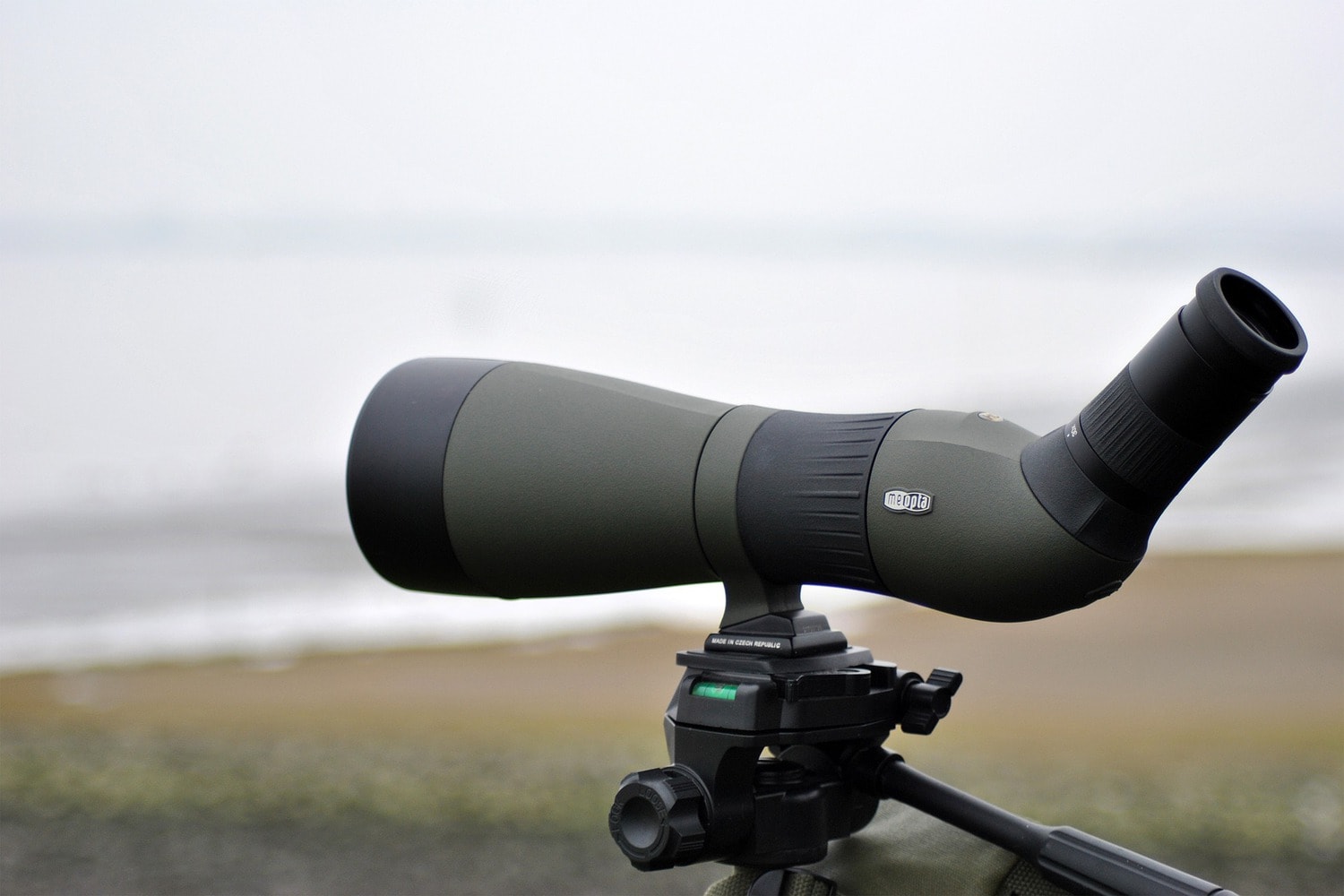The sight of birds in the wild is always a joy to a bird watcher or even a random Joe.
It even gets better when you can capture these mostly shy creatures without them scurrying off.
What if you want a better look at these birds without scaring them away?
Keep calm and use a spotting scope.
Spotting scopes give better image quality than binoculars and are bound to take your birding experience to another level with their long range.
In this article, I’ll save you a lot of stress and headache of going through tons of birding scope reviews without finding the right for you.
That said, I’ll review the best spotting scopes for birding across various price categories with their functions and how to pick the one that suits your needs best.
Before we get into the business of the day, I’d like to drop a hint for you when choosing the right spotting scope for birding.
Just like with binoculars, what you pay for is what you get.
In this regard, NEVER settle for cheap spotting scopes below $100 or even $200 if possible. They aren’t just worth it and is better you save up, if you have to, for a better one.
Quick Picks:
- Best Overall: Swarovski ATX 25-60x
- Best Under $1,500: Vortex Razor HD 27-60x
- Best Under $750: Vanguard Endeavour HD 20-60X
- Best Under $500: Vortex Diamondback 20-60X
Best Birding Scopes Reviewed For 2025
| Product | Details | ||
|---|---|---|---|
| 1. Swarovski ATX 25-60x |  Premium Pick |
Best Scope Money Can Buy
|
Check Price on Amazon |
| 2. Vortex Razor HD 27-60x |  |
Best Under $1,500
|
Check on OpticsPlanetCheck Price on Amazon |
| 3. Vanguard Endeavour HD 20-60X |  Best Value |
Best Under $750
|
Check on OpticsPlanetCheck Price on Amazon |
| 4. Vortex Diamondback 20-60X |  Perfect For Beginners |
Best Under $500
|
Check on OpticsPlanetCheck Price on Amazon |
Top-Class Spotting Scopes For Birding: $2,500+
1. Swarovski ATX 25-60x (85MM) - Best Overall

The Swarovski ATX is arguably the best bird watching scope money can buy on the market.
The ATX spotting scope costs between $3000 to $5000, and it varies because the angled zoom eyepiece and the objective lens are sold separately by the same company.
The high cost of this birding scope is due to the fact its lenses are made out of tough glass and are designed using cutting-edge technology to give the best possible image quality.
The ATX is made for use in the unpredictable outdoors such as safari trips, birding, and hunting trips. To this end, it has a sturdy frame that is finished with magnesium coatings to make it weather and fog-proof.
Though all the instruments together might seem like a lot of work to move around, it has a special case you can buy to do the trick.
In the end, you are most likely going to get remarks from your friends on your next birding adventure at the sight of this spotting scope alone. For its whopping price, I wouldn’t have expected anything less.
It gives you a clear and bright image that remains almost the same in low lighting due to its state-of-the-art optics. Plus, it is suitable for eyeglass wearers.
More so, you can transform it into the best spotting scope for digiscoping by purchasing the Swarovski TLS APO digiscoping adaptor if it’s your fancy. As expected from optic giants like Swarovski, it comes at a hefty price but with a range of quality features.
It is easy to mount and unmount, fits most DSLRs and phones, and has a lens that prevents chromatic aberration.
Technical Specs:
- Magnification - 25-60x
- Angled body design
- Objective lens diameter - 85mm
- Field of View - 124-68 ft
- Close Focus: Close focus -11.8ft
- Weight - 67.4 oz
2. Zeiss Victory Harpia 23-70X (95mm)

Shop the best spotting scope for birding made by optic giants Zeiss and you can be assured of a picturesque performance.
The Zeiss Victory Harpia's 95mm objective lens diameter ensures that it gathers enough light even in the dimmest of environments. In simple terms, you will get a frame-worthy picture if you bird watch or digiscope with this spotting scope.
The objective lens has a 3x angle zoom which allows it to retain the same image quality at all zoom ranges.
With a near-distance capacity of 4.5 meters, the scope does a good job of capturing epic up-close moments with small creatures like butterflies and dragonflies.
In newer versions, the zoom is placed close to the focus wheel for faster and easier focusing on moving birds. Even better, the focus wheel clicks at each turn.
In one of the spotting scope reviews I went through, an ornithologist was ecstatic about the new modifications because he was able to focus on moving birds using just one hand.
It costs between $3000 to $4500 which is one of the most expensive spotting scopes available. But if you are a professional photographer or birder, its quality makes up well for its price.
Technical Specs:
- Magnification: 23-70x
- Angled body design
- Objective lens diameter: 95mm
- Field of View: 176-58.5ft
- Close Focus: 14.8ft
- Weight: 73.3oz
Affordable Higher-Class Spotting Scopes For Birding: $750-$1500
1. Vortex Razor HD 27-60x (85mm)

The Vortex Razor HD doesn’t come cheap, but it also doesn’t break the bank and packs a punch of features that makes its price well worth it.
It has a remarkable range ability with a 68ft field of view which is not quite common at this price range.
The Razor’s lenses are crafted with cutting-edge optics technology that gives a razor-sharp image even at distances as far as 500 yards.
Its armor is all sorts of rugged with a tough Armor Tek exterior, O-ring sealed to keep out water and dust and fog proof. It also comes with a carry case and protective caps for its lenses.
The Razor is a great spotting scope for a birder to digiscope and watch birds from a distance with a clear image even in low light conditions. It’s no surprise since it has ED glass, apochromatic lenses, and anti-reflective coatings.
Also, it comes with a lifetime warranty for any damage done to it.
On the other hand, it might be a little hard to focus on max magnification (60x) as the focus knob is a little loose.
Still, its features are just as good as those of spotting scopes costing two times its money’s worth especially if you can get a tripod stand for better focus.
Technical Specs:
- Magnification - 27-60x
- Objective Lens Diameter - 85 mm
- Linear Field of View - 117-68 ft/1000 yds
- Angular Field of View - 2.2-1.3 degrees
- Close Focus - 16.4 feet
- Eye Relief - 16.7-17 mm
2. Nikon Monarch ED (82mm) 
Another handy spotting scope with a great mix of price and performance.
The Nikon Monarch spotting scope also comes with ED glass that gives bright, aberration-free images you will find in $4000+ products. With only obvious differences in low light conditions.
As you’d expect from optic giants like Nikon, it also comes with a trademark apochromatic optical system, and multi-layer coating on the lens and prism surfaces. This ensures better light transmission and color fringing.
Unsurprisingly, it offers the elementary features for standard spotting scopes like weather and fog-proof capabilities as well as long eye relief for eyeglass wearers.
On the flip side, its zooming and focus mechanism isn’t all that stable and can be a thorn in the flesh when viewing restless birds.
In all, the Nikon Monarch is well worth its price and is a good spotting scope for birding.
Technical Specs:
- Magnification: 20-60x
- Objective Lens Diameter: 82mm
- Angled body design
- Field of View: 111-51ft
- Close Focus: 16.4ft
- Weight: 57.8oz
Middle-Class Spotting Scopes For Birding: From $500 - $750
1. Vanguard Endeavour HD 20-60X 65MM

The Vanguard Endeavour HD is a great economy choice spotting scope that is not only affordable but also effective.
At such a low price, it features ED GLASS which is typically only found in way more expensive spotting scopes for enhanced image quality.
I picked the 65 mm objective lens because it is perfect for most birders, especially if you won’t be using it in low light environments. But you can opt for the 85mm instead if you are more into digiscoping than just viewing birds.
The Endeavour HD features all the basic features you are looking for in a decent spotting scope. Think sturdy design, anti-reflective coating for better light transmission, weather and fog proof, and a built-in sun shield.
In all, the Endeavour HD is a great pick at its price and features for the average birder.
Technical Specs:
- Magnification: 20-60X
- Extra-Low Dispersion glass for good image quality in low light conditions
- Waterproof and fog proof
Top Budget-Friendly Spotting Scope For Birding: Under $500
1. Vortex Diamondback 20-60X 80MM - Best for Beginners
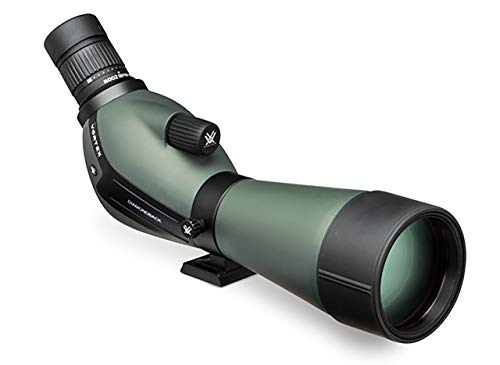
The Vortex Diamondback is one of a kind among spotting scopes in its price range.
It is Vortex’s cheapest spotting scope, and as you’d expect from an industry giant, they didn’t spare quality for that reason.
The Diamondback model offers birders a choice of angled or straight design in both its 60mm and 80mm objective lenses. Several birding reviews of this spotting scope suggest that the 80mm objective lens is the go-to choice.
Unlike the 60mm lens, it has a sturdy yet lightweight design even compared to other spotting scopes above its price range. And of course, has better image quality and range.
It even comes with a lifetime warranty regardless of the cause of damage.
However, if you intend to see minute details, like bird markings at distances farther than 150 yards, you have to use a tripod stand for improved focusing or get a better spotting scope altogether.
It comes with all other basic features you can find in more expensive birding scopes, like weatherproof, scratch resistant Armor Tek as well as multi-coated optics.
But, the drawback I found is that it lacks in field of view and close focus which requires much more expensive optics to get higher standards.
In the end, it isn’t hard to see why several spotting scope reviews for birding pick it as their economy choice.
Technical Specs:
- Magnification - 20-60x
- Objective Lens Diameter - 80mm
- Angled or Straight body design
- Field of View - 105-51 feet/1000 yards
- Close Focus - 22ft
- Weight - 47.1oz
2. Celestron Trailseeker 80MM

The Celestron Trailseeker spotting scope is a decent spotting scope that is affordable for almost any bird watcher.
For birders who are just using a spotting scope, the Ultima is a good choice to start with.
First, its image quality is amazing at its price, and you hardly get any color fringing. This high image quality is all thanks to Celestron’s XLT coatings.
It also has a durable design, which features weather and fog proof capabilities and nice ergonomic focusing knobs. It comes with several accessories, like eyepiece and objective lens cover, cleaning cloth and T-mount adapter.
Not to mention it’s not a stress to carry about thanks to its relatively lightweight and see-through carry on case.
Plus, you can get it with a universal smartphone adapter at a little added cost compared to other products if you want to do some digiscoping.
In reality, though, focusing becomes really hard when you go past 30x magnification.
Lastly, the Celestron Trailseeker is a steal for its price and is great for newbies who haven’t tried expensive spotting scopes.
Technical Specs:
- Magnification - 20-60x
- Objective lens diameter: 80mm
- Angular design model
- Field of view - 105-52ft
- Close focus: 24.6ft (8m)
- Eye Relief – 18-15
- Weight – 54.6oz
Choosing the Best Spotting Scopes For Birding
If you want to buy a good spotting scope for birding with your money, you might as well get good value for it. These tips would come in handy to help you make the right pick when shopping online or at your local store. Many of the same criteria apply whether you're searching for spotting scope vs binoculars as well.
And before I forget, let me remind you to capture those picture-perfect moments you'll have while birdwatching - so, one of the best wildlife cameras should very well be handy when the time is right.
1. Price Range
Spotting scopes are medium-range telescopes with a magnification power of up to 100x. For birding, you only need one within 20x-60x. Anything below or above and you are better off with a bird-watching binocular or telescope.
2. Magnification Power
As you should already know by now, the higher the price of the spotting scope the better the quality of performance. So, you need to find the best spotting scope in that fits not just your budget but also your kind of birding.
If you have the cash to splurge, the most expensive spotting scopes are sure to give you the kind of birding experience you can think of.
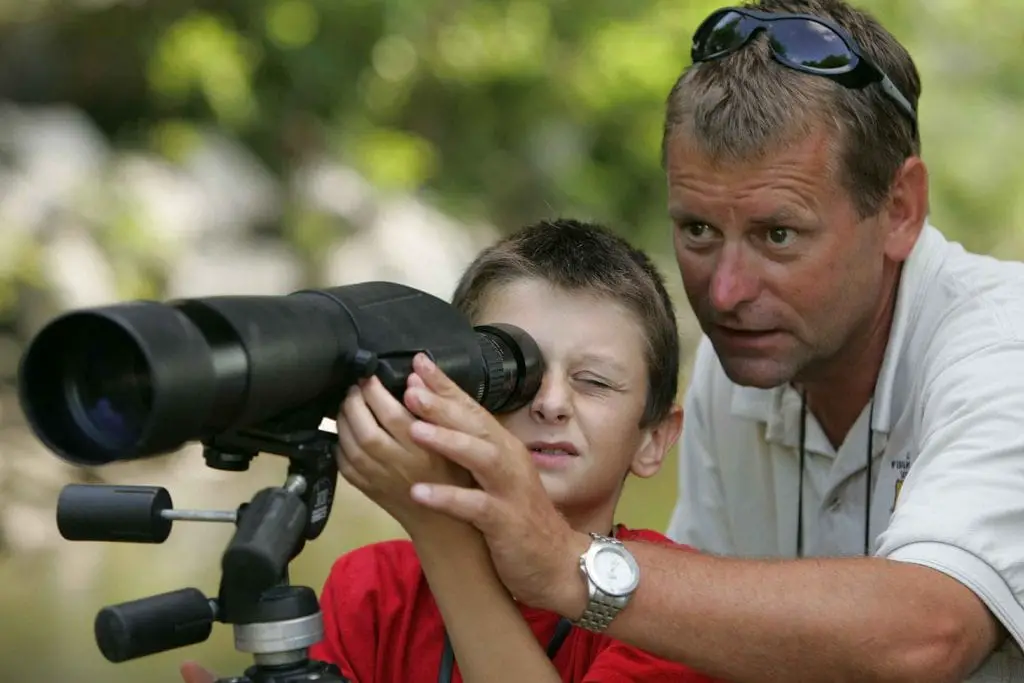
3. Zoom Lens
A zoom lens allows you to move through the magnification power (20-60x) with a simple adjustment mechanism while maintaining image clarity.
Most high and mid-priced spotting scopes will maintain image quality as sharp as at low magnification, but not with the cheap ones.
So, make sure you are a scope at the highest price you can afford if you want to pay attention to finer details like a bird’s pupil shape or eye color.
4. Glass Quality
The best spotting scopes are made with high density (fluorite coated) or extra-low dispersion (ED) glass.
The need for high glass quality is most noticeable when using cheaper binoculars in low light condition, like a sunset or at a powerful range. A spotting scope with HD or ED glass will stay considerably clear in these conditions.
5. Light Gathering Capacity
The ability of a spotting scope to gather more light makes it suitable for use in dim environments. It is determined by the size of the objective lens which is usually between 50mm to 100m.
A larger objective lens will give you better light gathering but also more money and luggage. So, if it isn’t completely necessary, opt for a smaller lens.
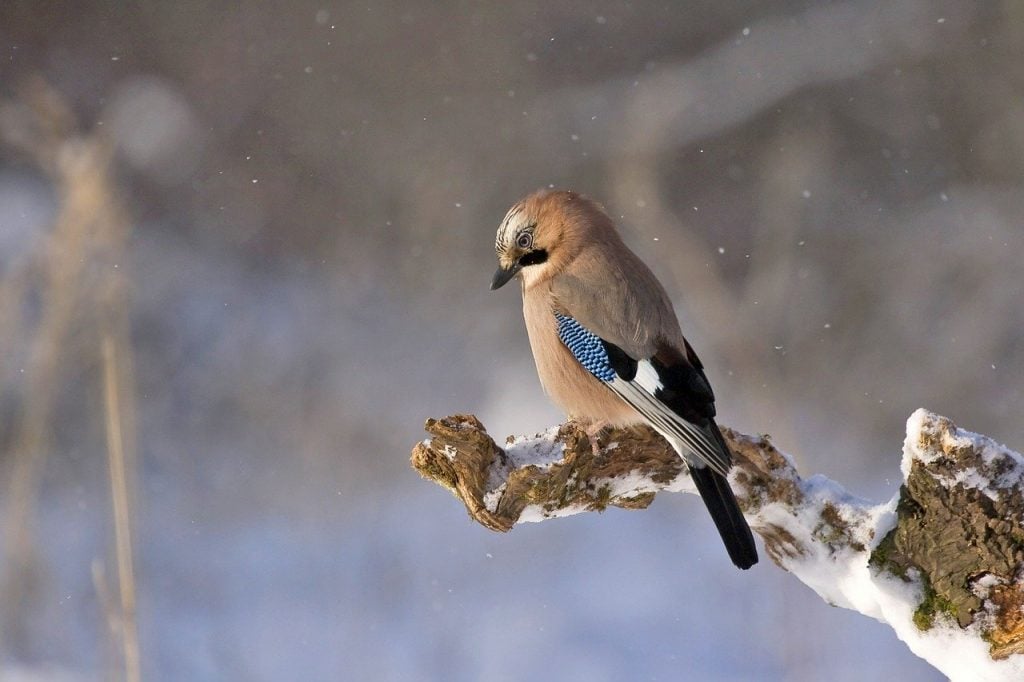
6. Eyepiece
The making and design of an eyepiece of a spotting scope are important when it comes to the effectiveness of the scope.
Some spotting scopes come with different detachable eyepieces while some have an adjustable all-in-one eyepiece. It really comes down to which one suits you best.
7. Angled or Straight Spotting Scope
Most spotting scopes for birding comes in two basic design options: either angled or straight design options.
The angled design option requires you to peer down into the eyepiece from an upright position while the straight spotting scope you will look straight ahead into the eyepiece.
The angled spotting scope allows you to look upwards whether towards a bird on a tree or a bird soaring through the sky while the straight spotting scope is appropriate for watching birds on the ground or birds in a pond.
8. Weather Protection
Birding in the great outdoors can be unpredictable at times, and you don’t know when the rain will come pouring down in the space of a minute.
With this in mind, getting a spotting scope that is both weatherproof and fog proof is a necessity.
The good thing is, all spotting scopes, except maybe the ridiculously cheap ones are equipped with these features.
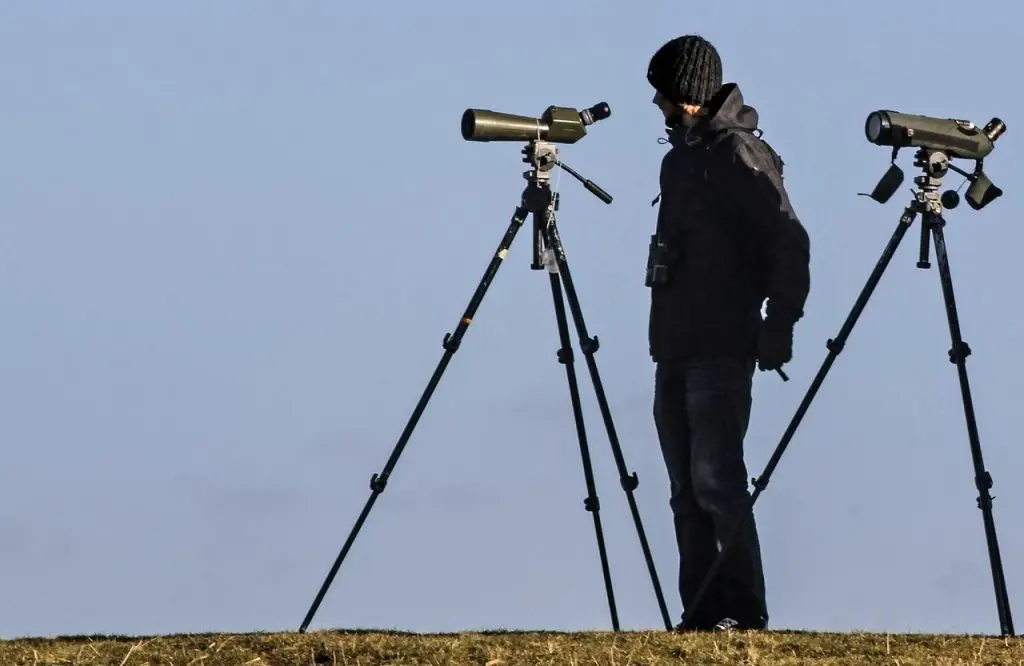
9. Focusing Mechanism
There are two types of focusing mechanism used in spotting scopes. Some designs have a focusing knob that would be twisted fully to get an improved focus. Others use an adjustment button placed on top of the spotting scope.
There is nothing like choosing a better focusing mechanism that suits your needs. As insignificant as it seems, it can make or mar your birding experience.
10. Eye Relief
This is simply the distance between the eye and the spotting scope while the space in between is called “field of view.”
It is very important that you maintain a 14mm field of view if you use eyeglasses, anything less will give an unclear image. Individuals using darker eyeglasses would need a larger field of view.
11. Tripods
A tripod stand is essential for stabilization if you will be using a birding scope at a high magnification range.
Unless you are using the spotting scope at the lowest magnification, you will also need to buy a tripod stand for your spotting scope.
Which One Should I Get?
If you are still looking for the best spotting scope for your next birding trip, then you are probably just a click away from it.
With the Swarovski ATX 25-60X (85MM) you can see the smallest of details in the most challenging environments if you are willing to pay its price. Its close focus makes it so close you feel you can touch a bird that’s 12ft away.
It is not only good for the casual bird watcher but also professionals like ornithologists, researchers and photographers.
And if you have under $500 to spare, you’ll enjoy the Vortex Diamondback 20-60X 80MM Spotting Scope on your next birding adventure!
